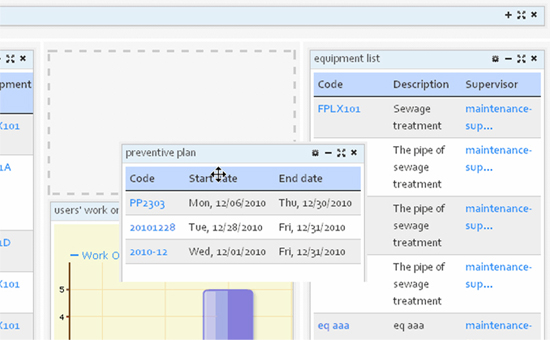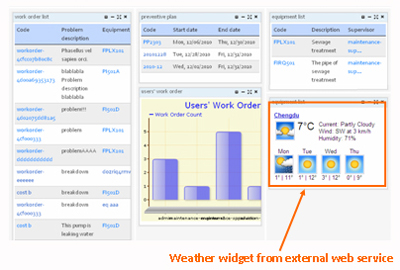Using widgets in bluebee® cloud
This month’s Tips & Tricks section is the first to be dedicated to bluebee® cloud.
bluebee® cloud is Siveco’s cloud computing platform for large multisite facility owners and FM companies. Totally integrated with the bluebee® mobile solution, bluebee® cloud is accessible over a secured internet connection from Siveco China datacenter or, for large customers, on their own infrastructure.
 An overview of bluebee® cloud
An overview of bluebee® cloud
Examples of applications of bluebee® cloud can be found in previously published case studies and announcements:
– Unified FM system key to continuing service level improvement for leading property group
– Carrefour China selects Siveco to implement nationwide Risk Prevention system
– Taking maintenance engineering services to new heights with Siveco’s cloud-based mobility solution
– Carrefour China selects Siveco to implement nationwide Risk Prevention system
– Taking maintenance engineering services to new heights with Siveco’s cloud-based mobility solution
What’s a widget?
bluebee® cloud is designed to be very intuitive, hence the use of a portal-style user interface similar to iGoogle or Yahoo! These pages are known as dashboards in bluebee® cloud. A dashboard is composed of many widgets which can then be organized, resized, reconfigured and moved around by simple drag-and-drop.
 Widgets can be moved around (similar to iGoogle or Yahoo!)
Widgets can be moved around (similar to iGoogle or Yahoo!)
A widget is simply a stand-alone application or portion of a webpage that can be embedded into the portal, for example, a “Weather Report Widget” could report today’s weather by accessing data from the Yahoo Weather or any other data source. Another widget could show data from the company’s own intranet or internet page.
Widget can be specially designed to display data from the system (or from an external data source), for example in the form of a chart, or to show live video feed from a security camera. Every functionality in bluebee® cloud is accessible in the form of a widget, which can then be setup by clicking on the “configure” button.

Widgets are typically created in HTML, JavaScript, Flash (not that Flash will not display on iPad) or CSS and often take the form of on-screen device (clocks, news feed, stock market tickers, daily weather etc.). Sites such as MassPublisher, SnackTools, FormLoop and Widgetbox, allow users to easily create widgets from their own content with no coding knowledge necessary.
Existing web services such as the Yahoo Weather report for a given city (for example that of the logged-in user) or customized Google maps, can easily be setup by end-users with the help of their IT department. Note that although the basic operation consists in a simple editing and cut & pasting code, a little troubleshooting is often needed.
 Example of widget calling external web service
Example of widget calling external web service
More advanced IT administrators can easily create new widgets or use this feature to integrate with more complex applications, such as GIS display, alarm feed, surveillance cameras, etc.
Example of widgets which can be integrated in bluebee® cloud dashboards:
– KPIs
– Reports
– Latest company announcements
– Weather report
– Emergency work orders list
– Custom Google or Baidu maps
– Chat and social media widgets
– Surveillance video feed
– Quick form to create a Job Request
– Form to contact IT support
– Search company directory
– Poll
– Reports
– Latest company announcements
– Weather report
– Emergency work orders list
– Custom Google or Baidu maps
– Chat and social media widgets
– Surveillance video feed
– Quick form to create a Job Request
– Form to contact IT support
– Search company directory
– Poll
And many more! As often with bluebee® cloud, your imagination is the limit!




